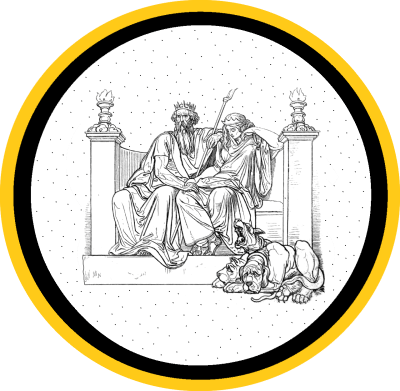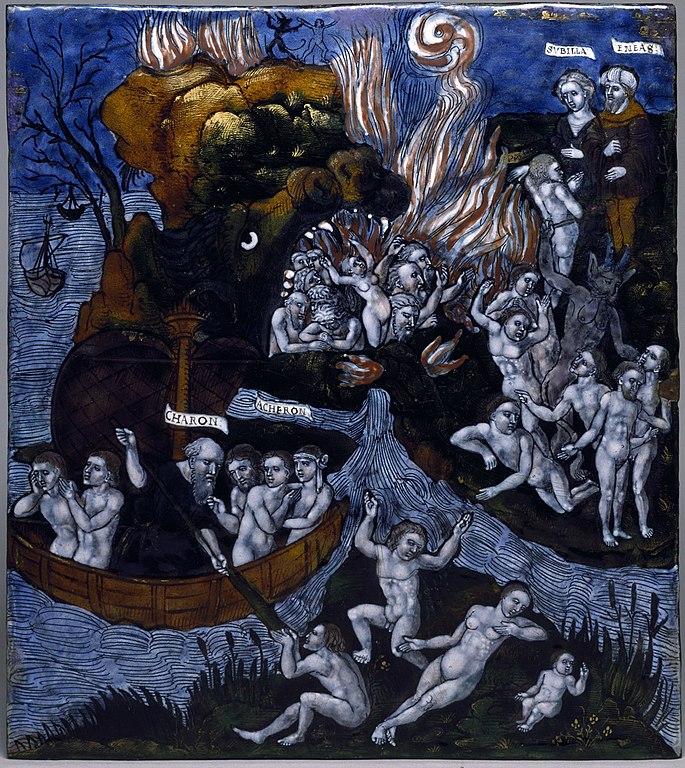DEATH GOD

His domain lies below the domain of MOTHER EARTH. In his possesion are all the riches of the Earth, minerals and precious metals. He owns a big herd of cattle. Most often he is also portrayed as a horned man.
Serpents made his domain their home. To get to his kingdom you have to cross the Great River. To do so you need a boat owned by an old ferryman who will require from you a payment in a form of a single coin.
People named Kimmerioi are described in Homer's Odyssey as living beyond the Oceanus, in a land of fog and darkness, at the edge of the world and the entrance of Hades.
The reminescence of watery Indo-European Slavic Death God might still be hidden in a Russian tale "The Sea Tsar and Vasilisa the Wise". The Sea Tsar or Sea King also appears in Slovak and Slovene folklore under a name Morskog Kralja and Morski kralj. He is also described as a "mighty and wealthy" regent who rules "in the depths of the sea", but he may also live "in the depths of the lake, or the pool or a swamp". The Sea Tsar has also been compared to an obscure Slavic deity named Korab, whose name means "boat" and who is possibly associated with the sea, navigation and fishing. In Polish culture there is also a version of this story from 19th century "Bajarz polski" titled "King Kojata".
Names of the Indo-European Death God
Vedic: यम (Yama) ("The Twin", he rides on a bull) निर्ऋति (Nirṛti)
Roman: Pluto ("The Wealthy") Dīs Pater ("Father of Riches") Orcus
Etruscan and Roman: Alpanu Libitina ("The one who freely takes everyone")
Greek: ᾍδης (Hades) ("The Invisible") Περσεφόνη (Persephone)
Dacian and Thracian: Derzelas (Darzalas) ("The Abundant")
East Slavic: Veles Мóкошь (Mokosh)
Kashubian: Wele Wetka ("Souls Lady")
Lithuanian: Velnias
Latvian: Velns Veļu Māte ("Mother Of Souls")
Etruscan: Veltha (Veltsa, Volsinii) Voltumna
Polabian: Triglav Tjarnaglofi Chernobog (similar to Odin and Trimurti/Rudra/Shiva as a God of War and Death)
Welsh: Arawn
Celtic: Morrigan Macha
Slavic: Morana Marzanna Morena Mara
Latvian: Māra ("The Plague")
Hindu: Mara
Estonian: Manna Tooni Marras Sarvik ("The Horned One")
Celtic Gallaeci: Berobreus Berobreo
Irish: Donn
Finnish: Tuoni ("The Darkness", When in human form, he appears as an old man with three fingers on each hand and a hat of darkness. He has a wife called Tuonetar.)
Polish: Nyja Nija ("The Decaying")
Lithuanian: Nijole Nijola (wife of Poklus)
Norse: Hel ("The Hidden", maybe from Pkel)
Norse: Odin (Associated with men hanged on gallows, with valknut, Valhalla and portrayed as an old man with grey beard)
Old Prussian: Pockols Peckols Picolli Pykullis Poklus (Portrayed as an old man with grey beard, maybe from "pecku" meaning cattle then his name would mean "Rich in Cattle")
Names of the Underworld
All names connected to "Pekel" mean "tar", "black pitch", for example it is "pek" in Dutch and "pix" in Latin, "pégoła" in Venetian, "խեժ (hež)" in Armenian from "*pes" .
Polish: Pkieł
Samogitian: Pekla
Old Prussian: Pekelle
Finnish: Pohjola (Frozen land in the North ruled by the daughter of Death God - Loviatar aka Louhiatar aka Louhi)
Old Prussian: Patollus Patals
Vedic: Patala ("Underworld", "that which is below the feet")
Norse: Valhöll ("Hall of the Fallen")
Finnish: Tuonela Manala
Roman: Manes ("Souls of the Dead")
Welsh: Annwn (Annun)
*Japanese: 黄泉 (Yomi)
In Greek myth Sibyl and Aeneas enter the cave leading to the Underworld and approach the river Acheron, which dead souls must cross to enter the Underworld. Aeneas spots a number of men from his fleet who have died, but they cannot cross because their bodies remain unburied. The Sibyl assures Aeneas's pilot Palinurus, that strangers will bury his body soon. Charon the ferryman of the dead challenges them, but the golden bough allows them to pass into the Underworld.

In the Underworld each type of dead soul has its own area. The marshes around the Styx hold the souls of the tragic dead infants, suiciders, and those killed by cruel love. Aeneas sees the spirit of Dido and tries to talk to her, but she angrily returns to her husband, Sychaeus. Moving on, they encounter dead heroes, both Trojan and Greek, and Aeneas visits Tartarus, where those who don't repent of their crimes or those who defy the gods are punished. Finally they use the golden bough to enter Elysium.
In the peaceful Elysian Fields, the soul of Anchises shows Aeneas their descendants waiting to be reborn into the world. Aeneas and the Sibyl return to the world of the living through the ivory Gates of Sleep.
The Orphic tradition preserved a different way of chosing the destination of a dead soul in Hades: "This is the leaf of Remembrance for the time when one shall die. You will go to the well fitted house of Hades: on the right hand there is a spring, and close to it a white cypress. This is the place where the descending souls cool themselves. Take good care not to come close to this spring (of forgetfulness; of oblivion). Further on you will find a cold stream flowing out of the lake of Remembrance (Mnemosyne). And there are guardians standing by the stream. They will ask you with shrewd mind, what for are you searching through the darkness of the deadly Hades...
Answer to them: "I am a son of the Heavy (Earth) and the starry Sky. But I am drained dry with thirst and I am perishing. So give me quickly cold water flowing out of the lake of Remembrance". And they will show mercy to you because of the king of the Netherworld, and will give to drink from the lake of Remembrance. Having you drunk from it, you will tread the holy path of the many, on which walk also the other glorious initiates and worshippers" (Pugliese Carratelli 1974, and 1993:20-31; for an English translation, Marcovich, 1976).
The Hittites believed that a soul can be brought to the Netherworld (the Meadows; the Wellus) by a bee, a duck (when one died in the sea; actually "lahhanza"; maybe a stork), a swan (when one died in a river), an eagle (when one died in the sky; probably in the mountains). Then it had to cross the road through the great river or a pool to get to the meadow[1].
In the 16th song of Finnish Kalevala, Väinämöinen arrives in the Realm of the Dead - Tuonela. Tuonetar is delighted to offer him a golden goblet of beer, but when he looks closer he can see it is really a black poison made of frog spawn, young poisonous snakes, lizards, adders, and worms. If a person drinks the brew, known as the beer of oblivion, they forget they ever existed and are unable to return to the land of the living, for only Tuonetar and Tuoni's children were allowed to leave Tuonela.
When Väinämöinen asks Tuonetar to reveal the three magic words he is seeking she refuses and vows that he will never leave Tuonela alive. She then puts him to sleep with her magic wand and has her three-fingered son weave a thousand nets of iron and copper to catch him if he tries to escape down the river of Tuoni. Väinämöinen succeeds in escaping by turning into a serpent and swimming through the nets, and when he returns to Kalevala he warns people never to sin lest they end up in Tuonela.
Article updated on the 17th of September 2021
